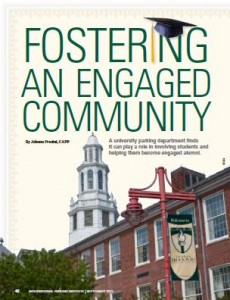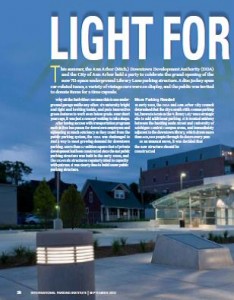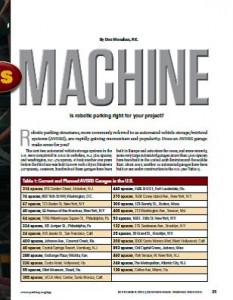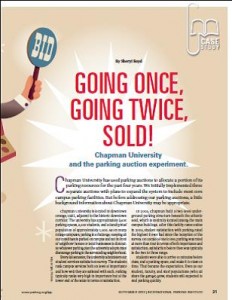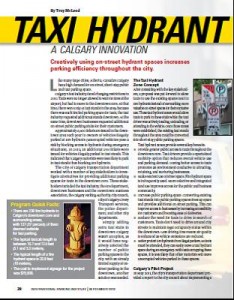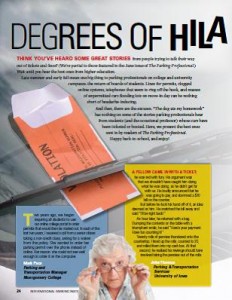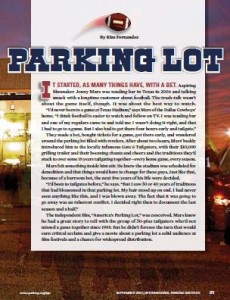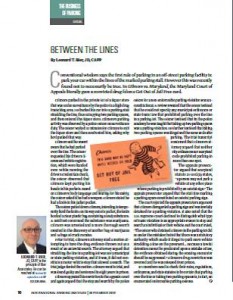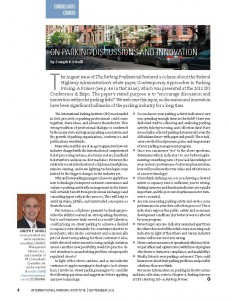Research shows that as public and private educational institutions compete
for quality students, engagement has become a crucial part of the formula for producing successful students. If institutions can provide an enriched learning and teaching environment, it follows that improved graduation and retention rates will be achieved. This adds value to the role of higher education in our states and regions.
Academic success leads to productive citizens, and we hope they’ll retain their ties with their universities and surrounding communities as their careers progress. If alumni feel the value of being connected to their colleges, the chances of giving and having a mutually beneficial future relationship with those institutions increase. Believe it or not, parking can play a role in this.
The College at Brockport
The State University of New York: College at Brockport, situated 20 minutes west of Rochester, N.Y., is a medium-sized, public liberal arts college. In recent decades, it has transformed itself by providing quality programs and instruction, and seeking a superior and diverse graduate and undergraduate student body. The college seeks national recognition as a comprehensive master’s institution that’s focused on student success. The administration at Brockport recognizes that success stems from engaged students, faculty, and staff, and seeks to achieve all of those through the four constructs of academic quality and engagement, co-curricular and support programs, learning environment and quality of place, and a culture of philanthropy and alumni connectedness.
Engagement
Webster’s Dictionary defines engagement as “emotional involvement or commitment.” We consider it a participatory activity— a two-way commitment.
Engagement is tied to academic quality in the illustration, but the four constructs overlap to allow for its application in a variety of ways. This is where the service departments in higher education can play an important role. Engagement doesn’t start and end in the classroom, and there are great things that happen with intentional community and employee engagement throughout the university.
As participants in the annual National Survey of Student Engagement (NSSE), Brockport is provided with a snapshot of how undergraduates spend their time while in school and what they gain from attending. Identified factors that influence student successes are closely monitored, allowing for changes in strategic policies and practices with a focus on improving the student experience. Students learn more when they are actively involved in their education and have opportunities to apply what they are learning in a variety of real-life settings.
Engagement at Parking and Transportation Services
As with many parking departments on college and university campuses, Brockport’s Parking and Transportation Services (PTS) oversees a variety of ancillary services. In addition to administering all aspects of parking and lot maintenance, PTS has assumed the responsibility for all campus transportation services. As a first point of contact for the public, the Ray H. Conrad Welcome Center houses not only parking, but all shuttle, bike borrowing, and carsharing services. Additionally, staff is also responsible for special event parking and many driver assistance services such as lock-outs, jumps, and taking gas to people who’ve run out.
Financial constraints have limited the number of permanent staff, and PTS relies heavily on the support of student employees. While this is helpful in containing payroll expenses, more importantly, it provides work experience for our students. Student applicants go through an interview process and formal customer service and technical orientations, and are offered numerous opportunities to step into leadership roles. In addition to their regular duties of office work, cashiering, database reporting, parking and enforcement, and programming, many of our students are groomed to be student managers or campus ambassadors at college-wide events. Students also gain experience in grant research, marketing, bike repair (in coordination with a local bike shop), and program development.
To align with the college’s mission of student engagement, PTS made a conscious decision to expand service learning by reaching out to the academic division for support and assistance with various projects. Service learning helps enrich the student connection with the community while they are still in college. Through these collaborative relationships, we have added value to both our services and enriched the student experience.
The Parking Ninja Video
Our first creative collaborative experience was with several students who majored in communications. They were asked to help create and produce an educational video that could be showcased at student orientation events for a long time—nothing too trendy or dated. Humor was used to put forth realistic parking expectations from the very start of a driver’s experience at Brockport. Watching a “Parking Ninja,” who is the main character in the video, new parents and students laugh while learning relevant information. Not only have the results been amazing, with significantly fewer citations at the beginning of this year as compared to past years, but the video has also helped change and soften our image. As an added bonus to the students’ experience creating the film, they earned college credit for their participation.
To see the video, go to YouTube.com and search “Brockport parking ninja.”
Environmental Awareness
In collaboration with the campus department of environmental service, we developed a shared student intern position. This intern had the responsibility of raising campus awareness about environmental issues and making suggestions for corrective measures. Specific to PTS, the student intern promoted alternatives to bringing a vehicle to campus and helped coordinate and promote the bike borrowing and carsharing programs. Reach has been extended to the larger community by providing assistance with the expansion of the community’s annual Walk! Bike! Brockport! event. Not only did this reduce the carbon footprint and educate the community, but it provided valuable public relations for our department.
Electronic Bicycle Administration
Arguably our most enriching relationship has been fostered with the department of computer science. Previously, the administration of our Fast Trax bike borrowing program was time consuming. All inventory tracking, membership recording, and bike use data entering was done manually and was in desperate need of greater efficiency. Students, under the direction of Professor Sandeep Mitra, developed a highly functional software system that met our needs.
This was a demanding project; according to Mitra, eight students spent about 235 hours each (1,880 total) in the development, testing, and customer interaction aspects of it. Thrilled with the outcome that would have taken us years to afford, the next phase would allow online registration of users and user access to their account, enabling them to monitor their rentals and charges.
One of the student developers involved in this project accepted a position as a developer with IBM and later told us, “I can honestly say that the Fast Trax application is what got me the job. Having real-world project experience and teamwork really sparked their interest and made it easy for me to impress them. The Fast Trax project was extremely valuable in my job hunting quest. It was the major factor that set me apart from other applicants. If possible, all computer science and specifically software development students should have the opportunity to participate in such a project. Being able to apply skills learned in previous classes into a working application for a real-world customer was extremely beneficial. This class provided vital insight into what to expect if you are looking to become a software developer in the real world.”
And Now the Challenge!
Brockport’s Parking and Transportation Services is committed to engagement and will continue to seek ways to provide our students with valuable experiences that will help them grow and be successful in their education, workplace, community and personal lives. There is no doubt we have prepared successful students and must continue to do so.
So the challenge is on. This has worked for us, and we encourage other parking leaders and managers to critically review their operations and find ways to engage students. Be part of the solution, engage, and be sure to share your successes!
Johnna Frosnini, CAPP, is administrator of parking and transportation services at The State University of New York: College at Brockport. She can be reached at jfrosini@brockport.edu or 585.395.7275.

